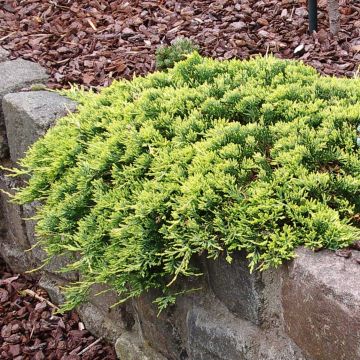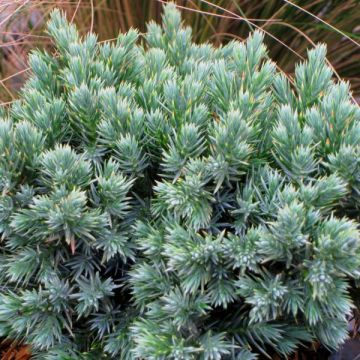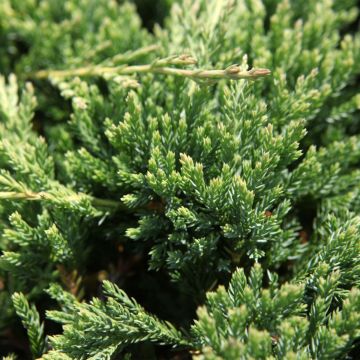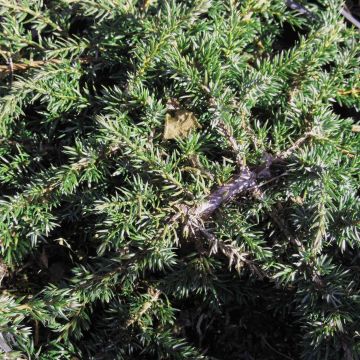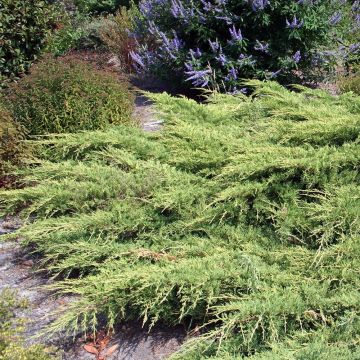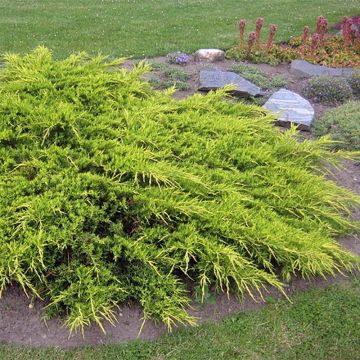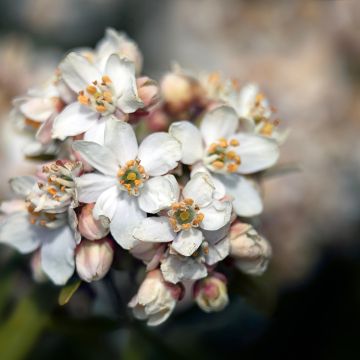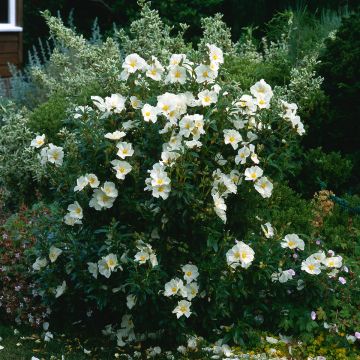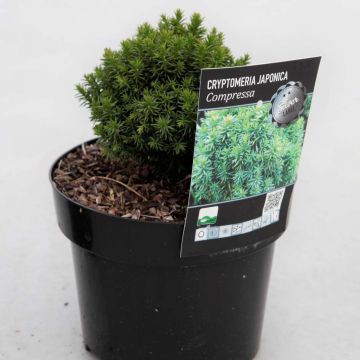Shipping country and language
Your country of residence may be:
Your country of residence is:
For a better user experience on our website, you can select:
Your shipping country:
Andorra
Austria
Belgium
Bulgaria
Canada
Chile
Croatia
Cyprus
Czechia
Denmark
Estonia
Finland
France
Germany
Greece
Hungary
Iceland
Ireland
Italy
Latvia
Lithuania
Luxembourg
Malta
Monaco
Netherlands
Poland
Portugal
Romania
Slovakia
Slovenia
Spain
Sweden
Switzerland
United Kingdom
We only deliver seed and bulb products to your country. If you add other products to your basket, they cannot be shipped.
Language:
French
German
Spanish
English
My Account
Hello
My wish lists
Plantfit
Log in / Register
Existing customer?
New customer?
Create an account to track your orders, access our customer service and, if you wish, make the most of our upcoming offers.


Juniperus horizontalis Prostrata


Juniperus horizontalis Prostrata
Juniperus horizontalis Prostrata
Juniperus horizontalis Prostrata
Creeping Juniper, Creeping Cedar, Creeping Savin
Why not try an alternative variety in stock?
View all →Order in the next for dispatch today!
Dispatch by letter from €3.90.
Delivery charge from €5.90 Oversize package delivery charge from €6.90.
More information
This item is not available in your country.
Schedule delivery date,
and select date in basket
This plant carries a 24 months recovery warranty
More information
We guarantee the quality of our plants for a full growing cycle, and will replace at our expense any plant that fails to recover under normal climatic and planting conditions.
From €5.90 for pickup delivery and €6.90 for home delivery
Express home delivery from €8.90.
Does this plant fit my garden?
Set up your Plantfit profile →
Description
Juniperus horizontalis 'Prostrata' is not the most common creeping juniper, but this variety is undoubtedly the most ground-covering of all. Over time, it forms a superb, very low, very wide, densely evergreen ground cover. Its foliage is green-grey with a slight bluish tint and is adorned with young purple-green shoots in spring. Vigorous and extremely hardy, this conifer is perfect for covering a large slope, a rock garden, or even in containers. It is also appreciated by bonsai enthusiasts. Give it full sun and well-drained soil, even poor, occasionally dry and calcareous.
Juniperus horizontalis is an evergreen and prostrate conifer belonging to the cypress family, which includes similar species such as cypresses and Chamaecyparis. It is native to the northern regions of North America, which explains its excellent hardiness. In its natural environment, it has a prostrate and spreading habit, reaching a thickness of 45cm (17.7in) and a spread of 2 to 4m (6ft 7in to 13ft 1in). This species prefers cool climates, poor, sandy and/or calcareous soils, and is not afraid of arid conditions.
The 'Prostrata' juniper, derived from this species, forms a prostrate bush after 10 years, with a very spreading habit, measuring 15 to 25cm (5.9 to 9.8in) in height and 1.20m (3ft 1in) in spread. It grows quite slowly when young, then its growth accelerates with age. An adult specimen will measure approximately 25cm (9.8in) in height and 3 to 4m in diameter, or even more. The spreading branches can root, so a single plant can eventually cover a large area. Its foliage consists of two types of leaves, with juvenile leaves having a scale-like appearance while adult leaves are needle-like. The tightly packed juvenile leaves release a resinous and aromatic scent when rubbed. Throughout the year, the foliage has a soft grey-green colour with slight bluish reflections. Junipers have a shallow root system that makes them fragile when it comes to transplantation, strong winds, and difficult to associate with perennials.
The 'Prostrata' creeping juniper is an extraordinary conifer, very undemanding, that conquers difficult areas of the garden as long as they are sunny. It can be easily adopted in a dry garden, on a large slope, among rocks, above a wall or a low wall, or near a pool, as it goes well with geometric lines and masonry works. It can also be planted near a water feature, cascading down a rocky slope. It also adapts well to container cultivation. The true graphical qualities of conifers naturally impose themselves in the design of a contemporary garden, which prefers the aesthetics of forms, silhouettes, and textures to the dance of blooms. These plants, with their reassuring permanence, provide lasting structure to a flower bed, mark pathways, border terraces, easily replacing the strong presence of trimmed boxwood. They also pair well with tousled grasses such as beach grass, with their very complementary temperament. The key is to play with volumes and colours.
Juniperus horizontalis Prostrata in pictures




Plant habit
Foliage
Botanical data
Juniperus
horizontalis
Prostrata
Cupressaceae
Creeping Juniper, Creeping Cedar, Creeping Savin
Cultivar or hybrid
Other Juniperus - Juniper
Planting and care
Juniperus horizontalis 'Prostrata' is planted from September to November and from February to June in well-drained, light, even limestone and poor soil. A rocky or sandy soil that occasionally dries out does not bother it. Choose a very sunny or semi-shaded location sheltered from prevailing winds. Soak the root balls well before planting. Add organic amendment at planting and water generously in the first years, in case of prolonged drought. Apply a special conifer fertilizer every year in April and cultivate the soil in summer. This very hardy conifer fears heavy, waterlogged soils in winter. Pruning is not necessary, on the contrary, as this plant expresses its full potential when allowed to grow freely. If pruning is necessary, do it between June and September. In this case, take care to only prune the young shoots, as old branches without needles do not regenerate.
Planting period
Intended location
Care
This item has not been reviewed yet - be the first to leave a review about it.
Evergreen shrubs
Haven't found what you were looking for?
Hardiness is the lowest winter temperature a plant can endure without suffering serious damage or even dying. However, hardiness is affected by location (a sheltered area, such as a patio), protection (winter cover) and soil type (hardiness is improved by well-drained soil).

Photo Sharing Terms & Conditions
In order to encourage gardeners to interact and share their experiences, Promesse de fleurs offers various media enabling content to be uploaded onto its Site - in particular via the ‘Photo sharing’ module.
The User agrees to refrain from:
- Posting any content that is illegal, prejudicial, insulting, racist, inciteful to hatred, revisionist, contrary to public decency, that infringes on privacy or on the privacy rights of third parties, in particular the publicity rights of persons and goods, intellectual property rights, or the right to privacy.
- Submitting content on behalf of a third party;
- Impersonate the identity of a third party and/or publish any personal information about a third party;
In general, the User undertakes to refrain from any unethical behaviour.
All Content (in particular text, comments, files, images, photos, videos, creative works, etc.), which may be subject to property or intellectual property rights, image or other private rights, shall remain the property of the User, subject to the limited rights granted by the terms of the licence granted by Promesse de fleurs as stated below. Users are at liberty to publish or not to publish such Content on the Site, notably via the ‘Photo Sharing’ facility, and accept that this Content shall be made public and freely accessible, notably on the Internet.
Users further acknowledge, undertake to have ,and guarantee that they hold all necessary rights and permissions to publish such material on the Site, in particular with regard to the legislation in force pertaining to any privacy, property, intellectual property, image, or contractual rights, or rights of any other nature. By publishing such Content on the Site, Users acknowledge accepting full liability as publishers of the Content within the meaning of the law, and grant Promesse de fleurs, free of charge, an inclusive, worldwide licence for the said Content for the entire duration of its publication, including all reproduction, representation, up/downloading, displaying, performing, transmission, and storage rights.
Users also grant permission for their name to be linked to the Content and accept that this link may not always be made available.
By engaging in posting material, Users consent to their Content becoming automatically accessible on the Internet, in particular on other sites and/or blogs and/or web pages of the Promesse de fleurs site, including in particular social pages and the Promesse de fleurs catalogue.
Users may secure the removal of entrusted content free of charge by issuing a simple request via our contact form.
The flowering period indicated on our website applies to countries and regions located in USDA zone 8 (France, the United Kingdom, Ireland, the Netherlands, etc.)
It will vary according to where you live:
- In zones 9 to 10 (Italy, Spain, Greece, etc.), flowering will occur about 2 to 4 weeks earlier.
- In zones 6 to 7 (Germany, Poland, Slovenia, and lower mountainous regions), flowering will be delayed by 2 to 3 weeks.
- In zone 5 (Central Europe, Scandinavia), blooming will be delayed by 3 to 5 weeks.
In temperate climates, pruning of spring-flowering shrubs (forsythia, spireas, etc.) should be done just after flowering.
Pruning of summer-flowering shrubs (Indian Lilac, Perovskia, etc.) can be done in winter or spring.
In cold regions as well as with frost-sensitive plants, avoid pruning too early when severe frosts may still occur.
The planting period indicated on our website applies to countries and regions located in USDA zone 8 (France, United Kingdom, Ireland, Netherlands).
It will vary according to where you live:
- In Mediterranean zones (Marseille, Madrid, Milan, etc.), autumn and winter are the best planting periods.
- In continental zones (Strasbourg, Munich, Vienna, etc.), delay planting by 2 to 3 weeks in spring and bring it forward by 2 to 4 weeks in autumn.
- In mountainous regions (the Alps, Pyrenees, Carpathians, etc.), it is best to plant in late spring (May-June) or late summer (August-September).
The harvesting period indicated on our website applies to countries and regions in USDA zone 8 (France, England, Ireland, the Netherlands).
In colder areas (Scandinavia, Poland, Austria...) fruit and vegetable harvests are likely to be delayed by 3-4 weeks.
In warmer areas (Italy, Spain, Greece, etc.), harvesting will probably take place earlier, depending on weather conditions.
The sowing periods indicated on our website apply to countries and regions within USDA Zone 8 (France, UK, Ireland, Netherlands).
In colder areas (Scandinavia, Poland, Austria...), delay any outdoor sowing by 3-4 weeks, or sow under glass.
In warmer climes (Italy, Spain, Greece, etc.), bring outdoor sowing forward by a few weeks.

